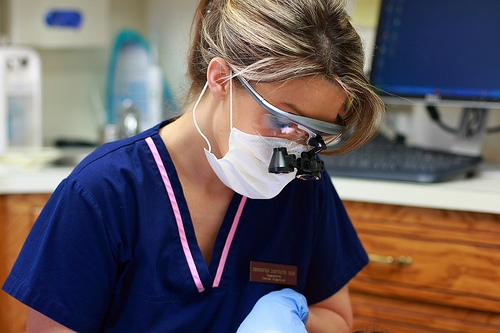April 26th, 2023

A popular option for straightening teeth at South & West Loop Dental, Invisalign can be a great method for improving your smile, and can help patients with crowded teeth, crossbites, overbites, underbites, and more.
Invisalign, which is different from traditional braces, works by applying a series of clear, retainer-like aligners in order to eventually move your teeth into their ideal positions. Patients typically swap aligners approximately every couple of weeks.
At South & West Loop Dental, we have lots of experience using this technology to give our patients the beautiful and healthy smile they’ve always wanted. During your initial visit at our Chicago office, the first thing we do is take an impression of your teeth as they are now and digitize it. Using special software, we look at the current positioning of your teeth and compare it to the way your teeth should look.
Not only are the aligners invisible, they are also removable, so you can eat and drink what you want, and brushing and flossing are easier. Invisalign’s aligners are also comfortable, with no metal to cause mouth abrasions during your treatment. And, no metal and wires usually means you spend less time at our office getting adjustments. With Invisalign, you can view your own virtual treatment plan when you start, so you can see how your straight teeth will look when your treatment is complete!
Depending on the severity of the problem, Invisalign treatment may take anywhere from three to 18 months to complete. You should be aware that Invisalign is not as effective as traditional braces in treating bite problems, teeth that are lower or higher than others, or severely overcrowded teeth. Both teens and adults are now great candidates for Invisalign, so we invite you to contact our Chicago office to set up an initial consultation and learn more on how Invisalign can give you the smile you’ve always wanted!
April 25th, 2023

You already know that taking care of your teeth can help prevent tooth decay and the need for extensive work such as root canals or implants, which can be inconvenient and expensive. But the benefits of good teeth can go far beyond having an attractive smile and being able to crunch carrots and chew meat.
The American Dental Association explains that healthy teeth are linked to a lower risk for heart disease and diabetes. Furthermore, recent research published in the British Journal of Sports Medicine states that good teeth can improve athletic performance among elite athletes.
Researchers examined the oral health of nearly 300 athletes in 25 sports at the 2012 Olympics in London. They looked for conditions such as dental caries, gingivitis, dental erosion, and periodontal disease, and asked about recent visits to a dentist.
Study investigators also asked athletes whether their oral health interfered with quality of life or athletic training and performance. The study concluded that poor oral health and fewer dental visits led to interference with preparation for competition.
This can happen for a few reasons. Tooth pain can disrupt sleep, which leads to slower reaction times. Oral health conditions can indicate chronic inflammation in the body, which means suboptimal performances on an elite level. Tooth pain can interfere with focus during training and competition.
Unfortunately, merely taking good care of your teeth won’t turn you into an Olympic gold medalist. However, the benefits can still be worthwhile. Even if healthy teeth provide little if any detectable gain in your athletic abilities, the potential benefits of maintaining a healthy mouth clearly go far beyond an attractive smile.
Practicing good oral hygiene and seeing Drs. Nasrin Azimzadeh, Kristina Djukic, and Tabasam Akbar regularly can promote your physical health, and maybe – just maybe – you will start to achieve an advantage over your weekend athletic opponents.
April 25th, 2023

During the early days of the environmental awareness movement, those who demonstrated against pollution, toxic chemicals, and the general public health were known as hippies. The early 1970s were a time of change, and assertions that we needed to pay more attention to the Earth's atmosphere were generally dismissed. But within a couple decades, it had become clear that the previous generation was right; the citizens of the world needed to become more environmentally conscious.
Many people feel that they can't make a difference if they don't do something big. But caring for the environment doesn't have to be an all-or-nothing concept. In fact, the little things you do can add up to make a great impact, especially in our community. Here are a few ways you can help the environment on Earth Day, April 22nd and all year around.
Four Small Ways to be Environmentally Friendly
- Recycle Your Textiles. Nearly 21 million tons of textiles are added to American landfills each year, according to the Environmental Protection Agency. Donating your unwanted clothing to a secondhand store or an organization that repurposes fabric helps cut down on solid waste and conserves natural resources.
- Reduce Usage of Disposables. Plastic bottles and bags, disposable diapers and other things we can use and toss out are convenient, but they're not necessary. Simply choosing to replace one of type of disposable with a reusable product can help you cut down on waste that has a large negative impact on our environment.
- Conserve Water. If everyone in the United States turned off the water while brushing their teeth, more than 1.5 million gallons of water could be conserved. Turn the water on long enough to wet your toothbrush for brushing and rinsing, and then immediately turn the water off again.
- Turn Off the Lights. Flip the light switch to "Off" if you're going to leave a particular room for 15 minutes or more. This will conserve energy on incandescent light bulbs and cut down on cooling costs.
It's not necessary to be an activist or install solar panels all over your home to help the environment. Although you can do these things, the little everyday measures make a big difference in helping to conserve energy and the environment, while reducing your carbon footprint. Our team at South & West Loop Dental wants to remind you to celebrate Earth Day and help the environment, knowing that it will benefit your and your children's generation.
April 24th, 2023

An article was released to the public stating that dental X-rays contribute to a type of brain cancer. After reading an article like this, your first thought may be to avoid dental X-rays, but you may want to hold off on that quick judgment. As with any treatment we offer at South & West Loop Dental, education is your most valuable tool in deciding what is best for you.
How often dental X-rays are taken is based on risk for infection, physical symptoms, and clinical findings. The American Dental Association (ADA) is a governing body over the dental profession. The ADA states, “ . . . healthy adults receive routine mouth X-rays every two to three years. Dental X-rays are recommended every one to two years for children and every 1.5 to three years for teens. Children often require more X-rays than adults because of their developing teeth and jaws and increased likelihood for cavities.”
A "caries risk category" often determines how often dental X-rays are taken. The most recent documented resource to determine a caries risk is Caries Management by Risk Assessment (CAMBRA). This was adopted by the ADA and is used by dental professionals giving interval recommendations for X-rays.
With knowledge of your risk for dental infection, you will be informed by Drs. Nasrin Azimzadeh, Kristina Djukic, and Tabasam Akbar of the interval at which dental X-rays should be taken. You can rest assured that the standards published by the ADA have been researched extensively and are there to protect your personal health and safety.
Dental X-rays are most commonly digital, which significantly reduces exposure. There is more radiation exposure from the sun or in an airplane than in a dental X-ray. It is common practice to use a lead apron with a thyroid collar for protection during X-ray exposure.
Having a cavity means having an active, potentially harmful infection. Diagnosing such infection with minimal exposure through digital dental X-rays at our Chicago office does more good than harm.



